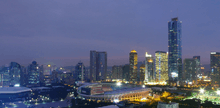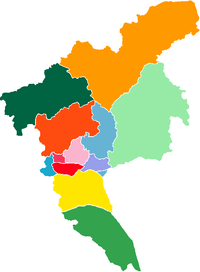Liwan District
Liwan District is one of 11 urban districts of the prefecture-level city of Guangzhou, the capital of Guangdong Province, China. The district is split into two parts by the Pearl River: Xiguan in the northeast and Fangcun in the southwest.
Liwan 荔湾区 | |
|---|---|
District | |
.jpg) Shamian Subdistrict riverfront | |

| |
 Liwan in Guangzhou | |
| Coordinates: 23°06′56″N 113°14′18″E | |
| Country | People's Republic of China |
| Province | Guangdong |
| Sub-provincial city | Guangzhou |
| Area | |
| • Total | 62.40 km2 (24.09 sq mi) |
| Population (2006) | |
| • Total | 705,262 |
| • Density | 11,000/km2 (29,000/sq mi) |
| Time zone | UTC+8 (China Standard) |
| Postal code | 510145 |
| Area code(s) | 020 |
| Website | http://www.lw.gov.cn/ |
| Liwan District | |||||||||||||||
|---|---|---|---|---|---|---|---|---|---|---|---|---|---|---|---|
| Simplified Chinese | 荔湾区 | ||||||||||||||
| Traditional Chinese | 荔灣區 | ||||||||||||||
| Guangdong Romanization | lei6 wan1 kêu1 | ||||||||||||||
| Hanyu Pinyin | Lìwān Qū | ||||||||||||||
| |||||||||||||||
| Alternative Chinese name | |||||||||||||||
| Simplified Chinese | 荔湾 | ||||||||||||||
| Traditional Chinese | 荔灣 | ||||||||||||||
| Guangdong Romanization | lei6 wan1 | ||||||||||||||
| Hanyu Pinyin | Lìwān | ||||||||||||||
| |||||||||||||||
| Second alternative Chinese name | |||||||||||||||
| Simplified Chinese | 西关 | ||||||||||||||
| Traditional Chinese | 西關 | ||||||||||||||
| Guangdong Romanization | sei1 guan1 | ||||||||||||||
| Hanyu Pinyin | Xiguān | ||||||||||||||
| |||||||||||||||
| Third alternative Chinese name | |||||||||||||||
| Chinese | 芳村 | ||||||||||||||
| Guangdong Romanization | fong1 qun1 | ||||||||||||||
| Hanyu Pinyin | Fāngcūn | ||||||||||||||
| |||||||||||||||
History
Liwan District was named after "Lizhiwan", which is derived from poem of "a bay of green water and red lychees along both banks". It covers an area of 16.2 square kilometres (6.3 sq mi) and has a permanent population of about 540,000 and a permanent nonnative population of over 200,000. Liwan District is positioned in the flourishing west part of Guangzhou, on the northeast bank of the Pearl River.
Liwan was originally a western suburb of Guangzhou known as Xiguan and Huadai/Huadi located in between two counties of Panyu County and Nanhai County. On 15 February 1921 Liwan along with Guangfu (present Yuexiu) formed the City of Guangzhou.
Fangcun, in the western part of Liwan District, lay at the southwest of Guangzhou's downtown area and south of Pearl River.[1] It was established as a "Fangcun District" in 1949 after the Chinese Communist Party took over Guangzhou from the Kuomintang.[2] In 2005, it was withdrawn and merged with Liwan.[3][4]
Administrative divisions
| Name | Chinese (S)[5] | Hanyu Pinyin | Canton Romanization | Population (2010)[6] | Area (km2) |
|---|---|---|---|---|---|
| Baihedong Subdistrict | 白鹤洞街道 | Báihèdòng Jiēdào | bag6 hog6 dung6 gai1 dou6 | 48,238 | 3.10 |
| Caihong Subdistrict | 彩虹街道 | Cǎihóng Jiēdào | coi2 hung4 gai1 dou6 | 54,348 | 1.06 |
| Chajiao Subdistrict | 茶滘街道 | Chájiào Jiēdào | ca4 geo3 gai1 dou6 | 54,918 | 4.05 |
| Changhua Subdistrict | 昌华街道 | Chānghuá Jiēdào | cêng1 wa4 gai1 dou6 | 32,778 | 1.61 |
| Chongkou Subdistrict | 冲口街道 | Chōngkǒu Jiēdào | cung1 heo2 gai1 dou6 | 48,097 | 4.20 |
| Dongjiao Subdistrict | 东漖街道 | Dōngjiào Jiēdào | dung1 gao3 gai1 dou6 | 35,889 | 4.60 |
| Dongsha Subdistrict | 东沙街道 | Dōngshā Jiēdào | dung1 Shā gai1 dou6 | 29013 | 7.90 |
| Duobao Subdistrict | 多宝街道 | Duōbǎo Jiēdào | do1 bou2 gai1 dou6 | 32,581 | 0.86 |
| Fengyuan Subdistrict | 逢源街道 | Féngyuán Jiēdào | fung4 yun4 gai1 dou6 | 59,337 | 0.78 |
| Hailong Subdistrict | 海龙街道 | Hǎilóng Jiēdào | hoi2 lung4 gai1 dou6 | 31,801 | 9.49 |
| Huadi Subdistrict | 花地街道 | Huādì Jiēdào | fa1 déi2 gai1 dou6 | 39,635 | 1.63 |
| Hualin Subdistrict | 华林街道 | Huálín Jiēdào | wa4 lem4 gai1 dou6 | 46,309 | 0.72 |
| Jinhua Subdistrict | 金花街道 | Jīnhuā Jiēdào | gem1 fa1 gai1 dou6 | 54,670 | 1.16 |
| Lingnan Subdistrict | 岭南街道 | Lǐngnán Jiēdào | ling5 nam4 gai1 dou6 | 27,560 | 0.90 |
| Longjin Subdistrict | 龙津街道 | Lóngjīn Jiēdào | lung4 zên1 gai1 dou6 | 43,518 | 0.53 |
| Nanyuan Subdistrict | 南源街道 | Nányuán Jiēdào | nam4 yun4 gai1 dou6 | 70,066 | 1.85 |
| Qiaozhong Subdistrict | 桥中街道 | Qiáozhōng Jiēdào | kiu4 zung1 gai1 dou6 | 31,643 | 4.40 |
| Shamian Subdistrict | 沙面街道 | Shāmiàn Jiēdào | sa1 min2 gai1 dou6 | 3,397 | 0.30 |
| Shiweitang Subdistrict | 石围塘街道 | Shíwéitáng Jiēdào | ség6 wei4 tong4 gai1 dou6 | 57,192 | 5.18 |
| Xicun Subdistrict | 西村街道 | Xicūn Jiēdào | sei1 qun1 gai1 dou6 | 45,069 | 3.27 |
| Zhanqian Subdistrict | 站前街道 | Zhànqián Jiēdào | zam6 qin4 gai1 dou6 | 27,431 | 0.96 |
| Zhongnan Subdistrict | 中南街道 | Zhōngnán Jiēdào | zung1 nam4 gai1 dou6 | 24,710 | 7.00 |
Transport
Liwan district has a well-developed transport network which enables it to reap benefits as an important place for business. There is a developed traffic network connecting with the railway station and Guangzhou Baiyun International Airport in the north. Renmin Bridge and Zhujiang Tunnel link the banks of the Pearl River in the southern part of Liwan. Zhujiang Bridge, which connects Nanhai and Foshan, links the east and west together in Liwan's west. Guangzhou South Railway Cargo Station of Jingguang Railway and Xinfeng Terminal are in Liwan's southwest. No. 107 State Highway and Guang-Fo Highway connecting with Guang-Shen Highway are through to Hong Kong. Line 1 of Guangzhou Metro and Inner overhead road pass through the District.
Metro
Liwan is currently service by four metro lines operated by Guangzhou Metro:
- Line 1 - Chen Clan Academy, Changshou Lu, Huangsha ( 6 ), Fangcun, Huadiwan, Kengkou, Xilang ( Guangfo )
- Line 5 - Jiaokou, Tanwei ( 6 ), Zhongshanba, Xichang, Xicun
- Line 6 - Hesha, Tanwei ( 5 ), Ruyifang, Huangsha ( 1 ), Cultural Park ( 8 )
- Line 8 - Cultural Park ( 6 )
- Guangfo line - Longxi, Jushu, Xilang ( 1 ), Hedong, Shachong
Tourism
Liwan District has many attractions and historical sites. The historically famous Lizhiwan (lit. Lychee Bay) has a 1000-year history. Shisanhang had a foreign trade privilege for hundred years. Haishan Xianguan had a leader of Lingnan horticulture, which made contribution to the development of Lingnan culture. Now, there are two national key protection units Chen Learning Academy (Chen Clan Temple) and Shamian Ancient Buildings, out of which Chen Learning Academy was elected one of the 8 new scenic spots of Guangzhou. There are several municipality-level relic spots: Hualin Temple, one of Guangzhou's Buddhist “five jungles”, Taoist Zhenwudi Renwei Temple, Jiang Guangding’s former residence, Li Wentian’s Taihua Building and Xiguan big house. In addition, there are historic sites where Dr. Sun Yat-sen, Zhan Tianyou, Chen Shaobai and Tang Tingguang lived or worked. There are Guangya School setup by Zhang Zhidong, a member of the Westernization Movement in the late Qing Dynasty and relic site of Xicun Industrial Zone developed by Chen Jitang when was in power during PC period. All those spots are like pearls dotted in this valuable land and show people its glorious and splendid past.
In order to integrate those typical spots organically for tourists’ convenience, Liwan District Administration divides them into 4 tourist areas, Xiguan Folk Custom Area, Chen Clan Temple Cultural and Leisure Area, Shamian Continental Tourist Area, and Shisanhang Commercial and Cultural Area. It is proposed to build large-scale “Lingnan Custom” tourist project at Xiguan Folk Custom Area so as to provide domestic and foreign tourists with all-directional services in tour, culture, leisure, foods and accommodation.
Liwan District's developed commerce. National ethical commercial street Shangxiajiu Pedestrian Street is arrayed with shops and gathers a lot of businessmen. in 1995, Shangxiajiu Lu was declared the first weekend commercial pedestrian street of Guangzhou. In 1996, it was elected one of the 10 tourist attractions of Guangzhou. There are many special streets such as blackwood and jade street, ceramic crafts street, and more than 100 wholesale markets engaged in traditional Chinese medicine, aquatic products, shoes, stationery, metal ware, textile (knitted), electric appliance (communications) and decoration materials, among which Qingping Traditional Chinese Herbs and Huangsha Aquatic Product Market are State-level markets; Yiyuan Stationery Market, Guangdong Electric Appliance City are province-level markets. Market is flourishing, which radiates the whole nation and the Southeast Asia as well as the world.
Liwan District is a gathering place of star-level restaurants of Guangzhou, including White Swan Hotel, Guangzhou Restaurant, Shengli Hotel, Qingping Restaurant, Taotaoju Restaurant, Lianxianglou Restaurant and Panxi Restaurant. Various special Liwan foods with long history and both famous at home and abroad are available, including Shunji coconut ice cream, Wuzhanji Jidi congee, Tingzai congee, Ouchengji dumpling and Nanxin double-condensed milk.
Education
Schools include:
- Guangzhou Xiehe High School (广州市协和中学)
- Guangzhou True Light Middle School (广州真光中学)
- Guangzhou Peiying Middle School (Formerly known as Guangzhou Puiying Middle School, 广州培英中学)
- The Thirty-Fifth Middle School (广州第三十五中学)
References
- Fangcun, Guangzhou' s Flower Base
- 芳村区 (Chinese Version)
- Three new districts established
- Liwan District Archived 2008-05-07 at the Wayback Machine
- http://zwgk.lw.gov.cn/lw01/jdxxgk/nmjd.shtml
- shi, Guo wu yuan ren kou pu cha ban gong; council, Guo jia tong ji ju ren kou he jiu ye tong ji si bian = Tabulation on the 2010 population census of the people's republic of China by township / compiled by Population census office under the state; population, Department of; statistics, employment statistics national bureau of (2012). Zhongguo 2010 nian ren kou pu cha fen xiang, zhen, jie dao zi liao (Di 1 ban. ed.). Beijing Shi: Zhongguo tong ji chu ban she. ISBN 978-7-5037-6660-2.
External links
| Wikimedia Commons has media related to Liwan District. |
| Wikivoyage has a travel guide for Guangzhou/Liwan. |

